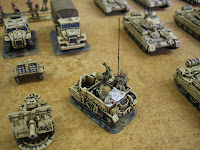
This scenario is based on the writings of Kermit the Hermit. Specifically, that section which has become known as the 'Parable of the Holy Turnip' (the lesson being - don't rub another mans turnip, it costs lives - apparently. The action took place sometime during the siege of Antioch but the exact date and location of the battle are unclear.


From the Chronicle of Kermit the Hermit:
"....with want coming upon the soldiers and pilgrims in the lines of Antioch, foraging parties were sent ever farther abroad into enemy country. One such party, led by a certain English captain named Baldrik, did raid the distant village of Blakadah, wherein the captain's men found fields in bounty of turnips. On the second day of the harvesting a piece of ground was dug, which since has been called Holy, where a large turnip, some say as big as a goose, in the shape of a Cross was discovered. It was thought to be a sign of God's Blessing.News of the discovery reached the lines of Antioch and caused a great disturbance among the devout who dwelt there. Many hundreds deserted the place and did pilgrimage to Blakadah in the hope of feasting on Gods Holy Turnips rather than await the assured arrival of the Holy Vegetable. Soon the place was athrong and the Turnips all eaten. That night the multitude slept happy and sated. But on the morrow the Saracen was discovered encamped nearby and their heathen cavalry all about, cutting off their route back to Antioch.Baldrik, immediately fortified Blakadah and deployed what forces, including the hapless pilgrims, as best he could. All prepared to defend themselves and many swore oaths to save the Holy Turnip from the clutches of the Hoards of Satan surrounding them.News of the Saracen reached Antioch within hours. It was decided, at council, that so great a number could not be sacrificed. Succour was dispatched under the command of Lord Melchitte and Lord Flashart...................."The Franks, army die D10.
Baldrik:
Baldrik command stand, leadership D10.
Holy Relic stand, applies only to the pilgrims under Baldrik (the rest of the Franks think it mad).
1 unit of mercenary English seamen.
1 unit of mercenary Italian seamen.
1 unit of fanatic levy (pilgrims) with simple bows.
1 unit of fanatic levy (pilgrims) with light spears.
2 units of fanatic civilians (pilgrims).
Lord Melchitte:
Melchitte command stand, leadership D10.
1 unit of knights.
1 unit of turcopoles.
3 small units of mercenary sergeants.
Lord Flashart:
Flashart command stand, leadership D12.
Otherwise as per Melchitte above.


The Saracens, Army die D10:
Three commands of Turcoman horse archers deployed around Blakadah (see map) each:
Command stand, leadership D10.
2 units of Turcoman horse archers.
Undeployed commands:
Command stand '1', leadership D10.
2 units of Turcoman horse archers.
2 units of Ghazis.
Command stand '2', leadership D10.
1 unit of Ghulams.
2 units of Seljuk horse archers.
4 units of Ghazis.
Special Rules:
The Saracen player adds a 'Special 1' and a 'Special 2' card to his sequence deck. On the appearance of the cards the player can elect to pass or deploy the command with the same number (command 1 or 2). If the card is passed on, the player can add or subtract 1 from the roll of a D10 the next time it is turned (passes are cumulative). If the player elects to deploy he rolls D10 adjusted by any 'passes'. The command must deploy on the command in the map square corresponding to the result (the relevant squares are numbered 1 - 10 on the deployment map above).
I'll post a report with pics ASAP. We play the 'Parable of the Holy Turnip Scenario' tonight.



























































